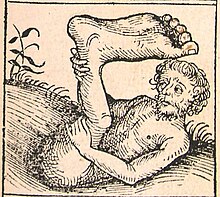Ctesias (/ˈtiːʒəs/ TEE-zhəs; Ancient Greek: Κτησίᾱς, romanized: Ktēsíās; fl. 5th century BC), also known as Ctesias of Cnidus, was a Greek physician and historian from the town of Cnidus in Caria, then part of the Achaemenid Empire.
Historical events

Ctesias, who lived in the fifth century BC, was physician to the Achaemenid king, Artaxerxes II, whom he accompanied in 401 BC on his expedition against his brother Cyrus the Younger. Ctesias was part of the entourage of King Artaxerxes at the Battle of Cunaxa (401 BC) against Cyrus the Younger and his Greek mercenaries called the Ten Thousand, when Ctesias provided medical assistance to the king by treating his flesh wound. He reportedly was involved in negotiations with the Greeks after the battle, and also helped their Spartan general Clearchus before his execution at the royal court at Babylon.
Ctesias was the author of treatises on rivers and on the Persian revenues, as well as an account of India, Indica (Ἰνδικά), and of a history of Assyria and Persia in 23 books, Persica (Περσικά), drawn from documents in the Persian Royal Archives, written in opposition to Herodotus, in the Ionic dialect.
Persica
Main article: Persica (Ctesias)The first six books of Persica cover the history of Assyria and Babylon to the foundation of the Persian empire in 550 BC by Cyrus the Great; the remaining 17 books cover the years to 398 BC. Of the two histories, abridgments by Photius and fragments are preserved by Athenaeus, Plutarch, Nicolaus of Damascus, and especially Diodorus Siculus, whose second book is derived mainly from Ctesias. As to the worth of Persica, much controversy occurred, both in ancient and modern times. Although many ancient authorities valued the work highly and used it to discredit Herodotus, a modern author writes, "(Ctesias's) unreliability makes Herodotus seem a model of accuracy." Reportedly, Ctesias's account of the Assyrian kings does not reconcile with the cuneiform evidence. The satirist Lucian thought so little of the historical reliability of Ctesias that in his satirical True Story he places Ctesias on an island where the evil were punished. Lucian wrote, "The people who suffered the greatest torment were those who had told lies when they were alive and written mendacious histories; among them were Ctesias of Cnidus, Herodotus, and many others."
According to the Encyclopædia Britannica, Ctesias mentioned that the grave of Darius I at Persepolis was in a cliff face that could be reached with an apparatus of ropes.
Indica
Main article: Indica (Ctesias)
A record of the view that the Persians held of India was written by Ctesias under the title Indica. It includes descriptions of artisans, philosophers, and people having the qualities of deities, as well as accounts of unquantifiable gold, among other riches and wonders. The work is of value as it documents the beliefs of the Persians about India. The book only remains in fragments and in reports made about the book by later authors.
References
- ^ [REDACTED] One or more of the preceding sentences incorporates text from a publication now in the public domain: Chisholm, Hugh, ed. (1911). "Ctesias". Encyclopædia Britannica. Vol. 7 (11th ed.). Cambridge University Press. p. 594.
- "The first certain event related to Ctesias is his medical assistance to the king during the battle of Cunaxa and his treatment of his flesh wound (Plut. Art. 11.3) in 401 BCE" in Dąbrowa, Edward (2014). The Greek World in the 4th and 3rd Centuries BC: Electrum vol. 19. Wydawnictwo UJ. p. 13. ISBN 9788323388197.
- Dąbrowa, Edward (2014). The Greek World in the 4th and 3rd Centuries BC: Electrum vol. 19. Wydawnictwo UJ. pp. 13–14. ISBN 9788323388197.
- Peter Frederick Barker, From The Scamander To Syracuse, Studies In Ancient Logistics, page 9, chapter 1.
- Lucian, A True Story, 2.31
- "Persepolis". Encyclopedia Britannica. 30 October 2023.
- Lavers, Chris (2009). The Natural History of Unicorns. New York, NY: Morrow. p. 5. ISBN 978-0-06-087414-8.
Further reading
- Ed., trad. et commentaire par Dominique Lenfant, Ctésias de Cnide. La Perse. L'Inde. Autres fragments, Collection Budé, Belles Lettres, Paris, 2004 (ISBN 2251005188).
- Schmitt, Rüdiger (1993). "CTESIAS". Encyclopaedia Iranica, Vol. VI, Fasc. 4. pp. 441–446.
- Jan P. Stronk: Ctesias' Persian History. Part I: Introduction, Text, and Translation, Wellem Verlag, Düsseldorf, 2010 (ISBN 9783941820012).
- Andrew G. Nichols, Ctesias: On India. Translation and Commentary, Duckworth, 2011, ISBN 1-85399-742-0
- Lloyd Llewellyn-Jones and James Robson, Ctesias' History of Persia: Tales of the Orient, Oxford, 2010 (ISBN 9780415364119).
External links
- Ctesias of Cnidus
- Overview of all fragments of the Persica and Indica by Jona Lendering
- Photius' Excerpt of Ctesias' Persica translated by J. H. Freese (1920)
- Photius' Excerpt of Ctesias' Indica translated by J.H. Freese (1920)
- Greek text (Müller 1858)
- Texts of Ctesias
- Classical-era Greek historians
- 4th-century BC historians
- 5th-century BC Greek physicians
- Ancient Cnidians
- Ancient Greeks from the Achaemenid Empire
- 5th-century BC births
- 4th-century BC deaths
- Historians from ancient Anatolia
- Physicians from the Achaemenid Empire
- Historians of Iran
- Greek Indologists
- Historians from the Achaemenid Empire
- People from Muğla Province
- Court physicians